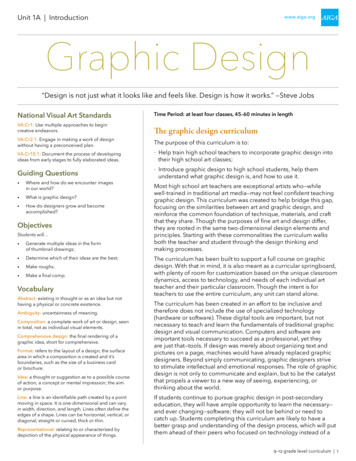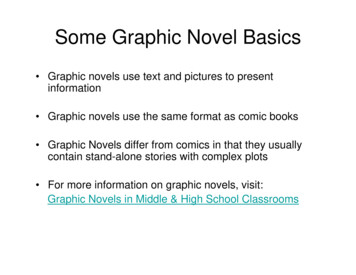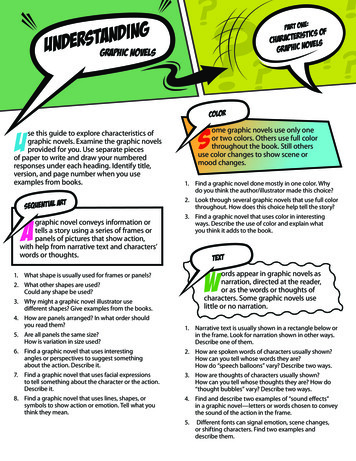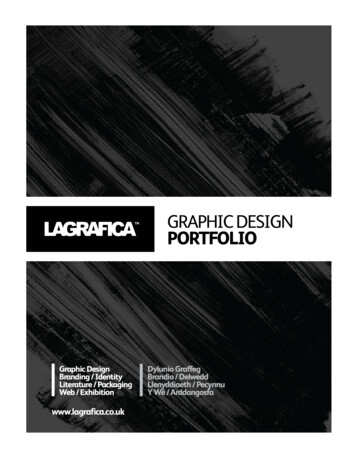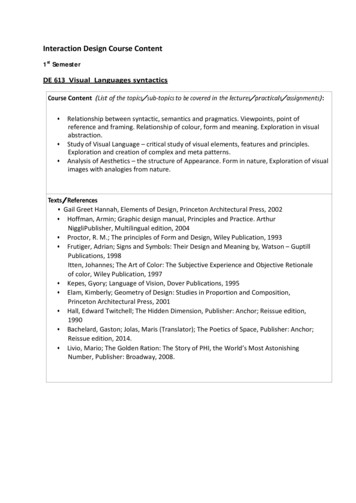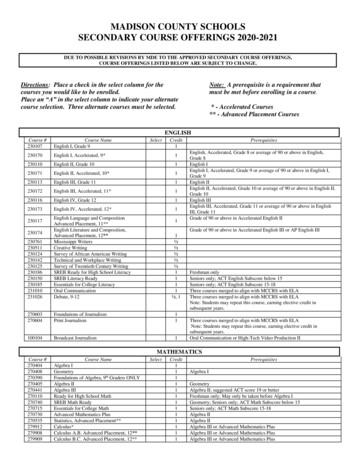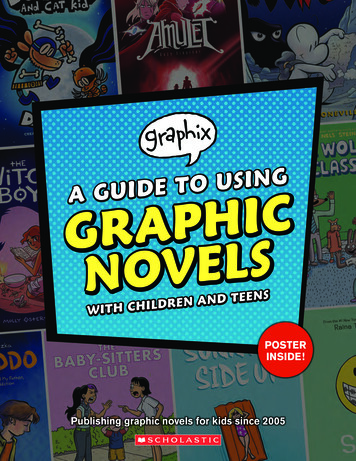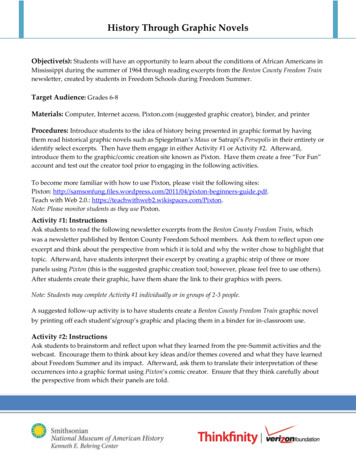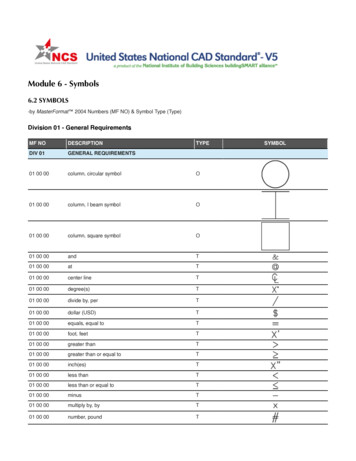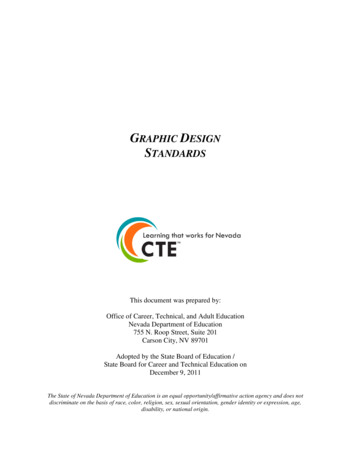
Transcription
GRAPHIC DESIGNSTANDARDSThis document was prepared by:Office of Career, Technical, and Adult EducationNevada Department of Education755 N. Roop Street, Suite 201Carson City, NV 89701Adopted by the State Board of Education /State Board for Career and Technical Education onDecember 9, 2011The State of Nevada Department of Education is an equal opportunity/affirmative action agency and does notdiscriminate on the basis of race, color, religion, sex, sexual orientation, gender identity or expression, age,disability, or national origin.
GRAPHIC DESIGN STANDARDS2011NEVADA STATE BOARD OF EDUCATIONNEVADA STATE BOARD FOR CAREER AND TECHNICAL EDUCATIONChristopher Wallace. PresidentDave Cook .Vice PresidentCraig Wilkinson . ClerkGloria Bonaventura . MemberWillia Chaney . MemberStavan Corbett . MemberDr. Cliff Ferry . MemberAdriana Fralick . MemberSandy Metcalf . MemberAnnie Yvette Wilson. MemberDaniela Sanchez . Student RepresentativeCTE MISSION STATEMENT:The Office of Career, Technical, and Adult Education is dedicated to developing innovativeeducational opportunities for students to acquire skills for productive employment and lifelong learning.NEVADA DEPARTMENT OF EDUCATIONKeith W. RheaultSuperintendent of Public InstructionRorie Fitzpatrick, Interim Deputy SuperintendentInstructional, Research, and Evaluative ServicesGreg Weyland, Deputy SuperintendentAdministrative and Fiscal ServicesMichael J. Raponi, DirectorOffice of Career, Technical, and Adult EducationRev: 12/9/2011Nevada CTE Standardsiii
GRAPHIC DESIGN STANDARDS2011TABLE OF CONTENTSNevada State Board of Education/Nevada Department of Education. iiiAcknowledgements/Writing Team Members/Project Coordinator . viiIntroduction . ixContent Standard 1.0 – Demonstrate knowledge of the graphics industry . 1Content Standard 2.0 – Apply elements and principles of design to communicate visually . 2Content Standard 3.0 – Demonstrate knowledge of the key aspects of production using industrystandard software . 3Content Standard 4.0 – Demonstrate knowledge of ethical and legal issues related to graphic design . 5Content Standard 5.0 – Create and maintain a personal portfolio. . 6Crosswalks and Alignments of Skill Standards and Common Core State Standards . 7Rev: 12/9/2011Nevada CTE Standardsv
GRAPHIC DESIGN STANDARDS2011ACKNOWLEDGEMENTSThe development of the Nevada Career and Technical Standards project was a collaborative effortsponsored by the Office of Career, Technical, and Adult Education at the Department of Education andthe Career and Technical Education Consortium of States. The Department of Education must rely onteachers and industry representatives who have the technical expertise and teaching experience todevelop standards and performance indicators that truly measure student skill attainment. Mostimportant, however, is recognition of the time, expertise and great diligence provided by the writingteam members in developing the Career and Technical Standards for Graphic Design.WRITING TEAM MEMBERSCindi Chang, InstructorSouthwest Career and Technical AcademyLas VegasMathew MacKay, InstructorReno High SchoolRenoMaureen Clark, InstructorSouthwest Career and Technical AcademyLas VegasRobert Mercer, InstructorPahrump Valley High SchoolPahrumpDonna Levy, CoordinatorClark County School DistrictLas VegasRosarita Olvina, InstructorWest Career and Technical AcademyLas VegasPROJECT COORDINATORMelissa Scott, Education Programs ProfessionalInformation and Media Technology EducationOffice of Career, Technical, and Adult EducationNevada Department of EducationRev: 12/9/2011Nevada CTE Standardsvii
GRAPHIC DESIGN STANDARDS2011INTRODUCTIONThe standards in this document are designed to clearly state what the student should know andbe able to do upon completion of an advanced high school Graphic Design program. These standardsare designed for a three-credit course sequence that prepares the student for a technical assessmentdirectly aligned to the standards.The Graphic Design Standards Writing Team determined that any statewide skill standards forGraphic Design programs must also prepare students for nationally-recognized certifications in industrysoftware. Many resources were considered and evaluated including Adobe Certified Associatecertification content. The standards were industry validated through the coordination of industryrepresentatives and the Office of Career, Technical, and Adult Education at the Nevada Department ofEducation.These exit-level standards are designed for the student to complete all standards through theircompletion of a program of study. These standards are intended to guide curriculum objectives for aprogram of study.The standards are organized as follows:Content Standards are general statements that identify major areas of knowledge,understanding, and the skills students are expected to learn in key subject and career areas by the end ofthe program.Performance Standards follow each content standard. Performance standards identify themore specific components of each content standard and define the expected abilities of students withineach content standard.Performance Indicators are very specific criteria statements for determining whether a studentmeets the performance standard. Performance indicators may also be used as learning outcomes, whichteachers can identify as they plan their program learning objectives.The crosswalk and alignment section of the document shows where the performance indicatorssupport the English Language Arts and Math Common Core State Standards and the Nevada StateScience Standards. Where correlation with an academic standard exists, students in the Graphic Designprogram perform learning activities that support, either directly or indirectly, achievement of one ormore Common Core State Standards.All students are encouraged to participate in the career and technical student organization(CTSO) that relates to their program area. CTSOs are co-curricular national associations that directlyenforce learning in the CTE classroom through curriculum resources, competitive events and leadershipdevelopment. CTSOs provide students the ability to apply academic and technical knowledge, developcommunication and teamwork skills, and cultivate leadership skills to ensure college and careerreadiness.The Employability Skills for Career Readiness identify the “soft skills” needed to be successfulin all careers, and must be taught as an integrated component of all CTE course sequences. Thesestandards are available in a separate document.Rev: 12/9/2011Nevada CTE Standardsix
GRAPHIC DESIGN STANDARDSCONTENT STANDARD 1.0 :2011DEMONSTRATE KNOWLEDGE OF THE GRAPHICSINDUSTRYPERFORMANCE STANDARD 1.1 : DEMONSTRATE KNOWLEDGE OF THE HISTORY OF THE GRAPHICDESIGN FIELD1.1.11.1.21.1.31.1.4Research technologies that advanced graphic designDescribe past, present, and future styles in the graphic design fieldIdentify art movements that impacted graphic designDescribe the importance of graphic design’s influence on societyPERFORMANCE STANDARD 1.2 : COMMUNICATE IDEAS USING APPROPRIATE INDUSTRYTERMINOLOGY1.2.11.2.2Formulate written and verbal communications using industry standard termsPrepare and deliver a visual presentation utilizing appropriate industry terminologyRev: 12/9/2011Nevada CTE Standards1
2011GRAPHIC DESIGN STANDARDSCONTENT STANDARD 2.0 :APPLY ELEMENTS AND PRINCIPLES OF DESIGN TOCOMMUNICATE VISUALLYPERFORMANCE STANDARD 2.1 : IDENTIFY AND APPLY THE ELEMENTS OF DESIGN2.1.12.1.22.1.32.1.42.1.5Identify the applications of color, line, shape, texture, size, and value in samples of graphic workAnalyze the use of color, line, shape, texture, size, and value in samples of graphic workIncorporate color, line, shape, texture, size, and value in student-generated graphic workDemonstrate the elements of design through manual sketchingDemonstrate the elements of design through digital sketchingPERFORMANCE STANDARD 2.2 : IDENTIFY AND APPLY THE PRINCIPLES OF DESIGN2.2.12.2.22.2.3Analyze the principles of balance, contrast, alignment, rhythm, repetition, movement, harmony,emphasis, and unity in samples of graphic works.Incorporate principles of balance, contrast, alignment, rhythm, repetition, movement, harmony,emphasis, and unity in student-generated graphic works.Demonstrate the principles of design through various drawing techniques.PERFORMANCE STANDARD 2.3 : IDENTIFY AND APPLY THE PRINCIPLES OF TYPOGRAPHY2.3.12.3.22.3.3Identify the anatomical components and qualities of type (i.e., x-height, ascenders, descenders,counters, etc.)Apply and adjust formatting to typeConstruct graphic works utilizing and manipulating typePERFORMANCE STANDARD 2.4 : APPLY PRINCIPLES AND ELEMENTS OF DESIGN TO 92.4.102Apply effective use of negative space, composition, message structure, graphics, etc., to graphicworksCreate graphic works utilizing gridsCreate graphic works utilizing templatesDemonstrate layout skills for print collaterals (i.e., business cards, newspapers, packaging, etc.)Demonstrate layout skills for digital mediaExplain the importance of consistency of designExplain the importance of usabilityExplain the importance of core messagingApply measurement tools and ratio analysis to image positioning in graphic worksSolve aspect ratio proportion measurement in video and animation developmentNevada CTE StandardsRev: 12/9/2011
GRAPHIC DESIGN STANDARDSCONTENT STANDARD 3.0 :2011DEMONSTRATE KNOWLEDGE OF THE KEY ASPECTSOF PRODUCTION USING INDUSTRY STANDARDSOFTWAREPERFORMANCE STANDARD 3.1 : DEMONSTRATE KNOWLEDGE OF CONCEPT DEVELOPMENT3.1.1 Generate project ideas through the use of thumbnails, roughs, mock-ups, wireframes, etc.3.1.2 Create a storyboard for a projectPERFORMANCE STANDARD 3.2 : DEMONSTRATE KNOWLEDGE OF IMAGE CREATION ze differences and appropriate applications of vector-based and bitmap imagesUse a variety of input devices to import photos, images, and other contentIncorporate the use of image manipulation and illustration software into final productsApply nondestructive image editing techniques such as layering and maskingPractice using different selection tools and techniques to manipulate imagesPractice in-camera composition and croppingPERFORMANCE STANDARD 3.3 : DEMONSTRATE APPLICATIONS OF MEDIA OUTPUTS3.3.1 Use appropriate resolution, compression, and file formats for various media outputs including web,video, and print3.3.2 Incorporate appropriate color modes in graphic works including but not limited to RGB and CMYKPERFORMANCE STANDARD 3.4 : DEMONSTRATE KNOWLEDGE OF THE GRAPHIC DESIGNWORKFLOW TO INCREASE SUCCESS AND PRODUCTIVITY3.4.13.4.23.4.33.4.4Develop a workflow for a projectSynthesize information collected from communications with various stakeholdersDescribe project managementCreate projects that define core messageRev: 12/9/2011Nevada CTE Standards3
2011GRAPHIC DESIGN STANDARDSPERFORMANCE STANDARD 3.5 : IDENTIFY AND APPLY THE DESIGN PROCESS3.5.1 Explain the design process3.5.2 Apply the design process to generate graphic worksPERFORMANCE STANDARD 3.6 : DEMONSTRATE KNOWLEDGE OF BRANDING AND CORPORATEIDENTITY3.6.1 Analyze branding and corporate identity, its purpose and constituents3.6.2 Create a visual that contains all the richness of the brand4Nevada CTE StandardsRev: 12/9/2011
GRAPHIC DESIGN STANDARDSCONTENT STANDARD 4.0 :2011DEMONSTRATE KNOWLEDGE OF ETHICAL ANDLEGAL ISSUES RELATED TO GRAPHIC DESIGNPERFORMANCE STANDARD 4.1 : DEMONSTRATE KNOWLEDGE OF COPYRIGHT AND INTELLECTUALPROPERTY LAW4.1.1 Research laws governing copyright, intellectual property (including font usage, photography,illustration, audio and video rights), and software licensing4.1.2 Research laws governing brand issues, trademark, and other proprietary rights4.1.3 Discuss consequences of violating copyright, privacy, and data security laws4.1.4 Define and debate fair use including authorships, rights of use for work and likeness, and credit lines4.1.5 Model fair use in production of graphic worksPERFORMANCE STANDARD 4.2 : DEMONSTRATE ETHICAL BEHAVIOR AS IT RELATES TO THEINDUSTRY4.2.14.2.24.2.34.2.44.2.5Research and discuss censorship as it applies to the graphic design industryResearch the purpose of non-disclosure agreements (NDA)Incorporate cultural sensitivity and diversity awareness into the design processDebate legal versus ethical behaviorsIncorporate ethical behaviors in graphic projectsRev: 12/9/2011Nevada CTE Standards5
2011CONTENT STANDARD 5.0 :GRAPHIC DESIGN STANDARDSCREATE AND MAINTAIN A PERSONAL PORTFOLIOPERFORMANCE STANDARD 5.1 : CREATE AND MAINTAIN A PERSONAL PORTFOLIO5.1.1 Research and compare the various types of personal portfolios5.1.2 Develop graphics portfolios that include traditional and digital works5.1.3 Recognize that portfolios are dynamic and require maintenancePERFORMANCE STANDARD 5.2 : DEMONSTRATE THE PROCESS OF EVALUATING PORTFOLIOS5.2.1 Conduct peer and self evaluations using rubrics5.2.2 Understand the elements of the critique process, including a respect for peer work and the ability togive and receive dispassionate criticism6Nevada CTE StandardsRev: 12/9/2011
GRAPHIC DESIGN STANDARDS2011CROSSWALK AND ALIGNMENTS OFGRAPHIC DESIGN STANDARDSAND THE COMMON CORE STATE STANDARDSAND THE NEVADA SCIENCE STANDARDSCROSSWALKThe crosswalk of the Graphic Design Standards shows links to the Common Core State Standards andidentifies the performance indicators in which the learning objectives in the Graphic Design programsupport academic learning. The performance indicators are grouped according to their contentstandard and are crosswalked to the English Language Arts and Math Common Core State Standardsand Nevada State Science Standards.ALIGNMENTSIn addition to correlation with the Common Core Math Standards, many performance indicatorssupport the Common Core Mathematical Practices. The following table illustrates the alignment ofthe Graphic Design Standards Performance Indicators and the Common Core Mathematical Practices.This alignment identifies the performance indicators in which the learning objectives in the GraphicDesign program support academic learning.Rev: 12/9/2011Nevada CTE Standards7
2011GRAPHIC DESIGN STANDARDSThis Page was Intentionally Left Blank8Nevada CTE StandardsRev: 12/9/2011
GRAPHIC DESIGN STANDARDS2011CROSSWALK OF GRAPHIC DESIGN STANDARDSAND THE COMMON CORE STATE STANDARDSCONTENT STANDARD 1.0:DEMONSTRATE KNOWLEDGE OF THE GRAPHICS INDUSTRYPerformanceCommon Core State Standards and Nevada Science StandardsIndicators1.1.1English Language Arts: Writing Standards for Literacy in Science and Technical SubjectsWHST. 11-12.7 Conduct short as well as more sustained research projects to answer a question(including a self-generated question) or solve a problem; narrow or broaden the inquirywhen appropriate; synthesize multiple sources on the subject, demonstratingunderstanding of the subject under investigation.WHST.11-12.81.1.2Gather relevant information from multiple authoritative print and digital sources, usingadvanced searches effectively, assess the strengths and limitations of each source interms of the task, purpose, and audience; integrate information into the text selectivelyto maintain the flow of ideas, avoiding plagiarism and overreliance on any one sourceand following a standard format for citation.English Language Arts: Reading Standards for Informational TextRI.11-12.3Analyze a complex set of ideas or sequence of events and explain how specificindividuals, idea, or events interact and develop over the course of the textEnglish Language Arts: Writing Standards for Literacy in Science and Technical SubjectsWHST. 11-12.7 Conduct short as well as more sustained research projects to answer a question(including a self-generated question) or solve a problem; narrow or broaden the inquirywhen appropriate; synthesize multiple sources on the subject, demonstratingunderstanding of the subject under investigation.WHST.11-12.81.1.3Gather relevant information from multiple authoritative print and digital sources, usingadvanced searches effectively, assess the strengths and limitations of each source interms of the task, purpose, and audience; integrate information into the text selectivelyto maintain the flow of ideas, avoiding plagiarism and overreliance on any one sourceand following a standard format for citation.English Language Arts: Language StandardsL.11-12. 6Acquire and use accurately general academic and domain-specific words and phrases,sufficient for reading writing, speaking and listening at the college and career readinesslevel; demonstrate independence in gathering vocabulary knowledge when consideringa word or phrase important to comprehension or expression.English Language Arts: Reading Standards for Informational TextRI.11-12.3Analyze a complex set of ideas or sequence of events and explain how specificindividuals, idea, or events interact and develop over the course of the text.English Language Arts: Writing Standards for Literacy in Science and Technical SubjectsWHST. 11-12.7 Conduct short as well as more sustained research projects to answer a question(including a self-generated question) or solve a problem; narrow or broaden the inquirywhen appropriate; synthesize multiple sources on the subject, demonstratingunderstanding of the subject under investigation.WHST.11-12.8Gather relevant information from multiple authoritative print and digital sources, usingadvanced searches effectively, assess the strengths and limitations of each source interms of the task, purpose, and audience; integrate information into the text selectivelyto maintain the flow of ideas, avoiding plagiarism and overreliance on any one sourceand following a standard format for citation.English Language Arts: Language StandardsL.11-12. 6Acquire and use accurately general academic and domain-specific words and phrases,sufficient for reading, writing, speaking, and listening at the college and careerreadiness level; demonstrate independence in gathering vocabulary knowledge whenconsidering a word or phrase important to comprehension or expression.Rev: 12/9/2011Nevada CTE Standards9
20111.1.4GRAPHIC DESIGN STANDARDSEnglish Language Arts: Writing Standards for Literacy in Science and Technical SubjectsWHST. 11-12.7 Conduct short as well as more sustained research projects to answer a question(including a self-generated question) or solve a problem; narrow or broaden the inquirywhen appropriate; synthesize multiple sources on the subject, demonstratingunderstanding of the subject under investigation.WHST.11-12.81.2.1Gather relevant information from multiple authoritative print and digital sources, usingadvanced searches effectively, assess the strengths and limitations of each source interms of the task, purpose, and audience; integrate information into the text selectivelyto maintain the flow of ideas, avoiding plagiarism and overreliance on any one sourceand following a standard format for citation.English Language Arts: Language StandardsL.11-12.1Demonstrate command of the conventions of standard English Grammar and usagewhen writing or speaking.L.11-12. 2Demonstrate command of the conventions of standard English capitalization,punctuation, and spelling when writing.L.11-12.4cConsult general and specialized reference materials both print and digital, to find thepronunciation of wordL.11-12. 6Acquire and use accurately general academic and domain-specific words and phrases,sufficient for reading, writing, speaking, and listening at the college and careerreadiness level; demonstrate independence in gathering vocabulary knowledge whenconsidering a word or phrase important to comprehension or expression.English Language Arts: Writing Standards for Literacy in Science and Technical SubjectsWHST.11-12. 2a Introduce a topic: organize complex ideas, concepts, and information so that teach newelement builds on that which precedes it to create a unified whole; include formatting(e.g. headings), graphics (e.g., figures, tables), and multimedia when useful to aidingcomprehension.WHST.11-12. 2b Develop the topic thoroughly by selecting the most significant and relevant facts,extended definitions, concrete details, quotations, or other information and examplesappropriate to the audience’s knowledge of the topic.WHST.11-12. 2c Use appropriate and varied transitions and syntax to link the major sections of the text,create cohesion, and clarify the relationship among complex ideas and concepts.WHST.11-12. 2d Use precise language, domain-specific vocabulary, and techniques such as metaphor,simile, and analogy to manage the complexity of the topic.WHST.11-12. 2e Establish and maintain a formal style and objective tone while attending to the normsand conventions of the discipline in which they are writing.WHST.11-12. 2f Provide a concluding statement or section that follows from and supports theinformation or explanation presented (e.g. articulating implications or the significanceof the topic).Continue on next page .10Nevada CTE StandardsRev: 12/9/2011
GRAPHIC DESIGN STANDARDS1.2.12011English Language Arts: Writing Standards for Literacy in Science and Technical SubjectsWHST.11-12.4 Produce clear and coherent writing in which the development, organization, and styleare appropriate to task, purpose, and audience.WHST.11-12.5Develop and strengthen writing as needed by planning, revising, editing, rewriting, ortrying a new approach, focusing on addressing what is most significant for a specificpurpose ad audience.WHST.11-12.6Use technology, including the internet, to produce, publish, and update individual orshared writing products in response to ongoing feedback, including new arguments orinformation.WHST. 11-12.7Conduct short as well as more sustained research projects to answer a question(including a self-generated question) or solve a problem; narrow or broaden the inquirywhen appropriate; synthesize multiple sources on the subject, demonstratingunderstanding of the subject under investigation.WHST.11-12.81.2.2Gather relevant information from multiple authoritative print and digital sources, usingadvanced searches effectively, assess the strengths and limitations of each source interms of the task, purpose, and audience; integrate information into the text selectivelyto maintain the flow of ideas, avoiding plagiarism and overreliance on any one sourceand following a standard format for citation.English Language Arts: Speaking and Listening StandardsSL.11-12.5Make strategic use of digital media (e.g., textual, graphical, audio, visual, andinteractive elements) in presentations to enhance understanding of findings, reasoning,and evidence and to add interest.SL.11-12.6Adapt speech to a variety of contexts and tasks, demonstrating a command of formalEnglish when indicated or appropriate. (See grades 11-12 Language standards 1 and 3for specific expectations).English Language Arts: Language StandardsL.11-12. 6Acquire and use accurately general academic and domain-specific words and phrases,sufficient for reading, writing, speaking, and listening at the college and careerreadiness level; demonstrate independence in gathering vocabulary knowledge whenconsidering a word or phrase important to comprehension or expression.Rev: 12/9/2011Nevada CTE Standards11
2011GRAPHIC DESIGN STANDARDSCONTENT STANDARD 2.4.42.4.62.4.72.4.812APPLY ELEMENTS AND PRINCIPLES OF DESIGN TO COMMUNICATEVISUALLYCommon Core State Standards and Nevada Science StandardsEnglish Language Arts: Reading Standards for Informational TextRI.11-12.7Integrate and evaluate multiple sources of information presented in different media orformats (e.g., visually, quantitatively) as well as in words in order to address a questionor solve a problem.English Language Arts: Speaking and Listening StandardsSL.11-12. 5Make strategic use of digital media (e.g., textual, graphical, audio, visual, andinteractive elements) in presentations to enhance understanding of findings, reasoning,and evidence and to add interest.English Language Arts: Reading Standards for Informational TextRI.11-12.7Integrate and evaluate multiple sources of information presented in different media orformats (e.g., visually, quantitatively) as well as in words in order to address a questionor solve a problem.English Language Arts: Language StandardsL.11-12. 6Acquire and use accurately general academic and domain-specific words and phrases,sufficient for reading writing, speaking and listening at the college and career readinesslevel; demonstrate independence in gathering vocabulary knowledge when consideringa word or phrase important to comprehension or expression.English Language Arts: Language StandardsL.11-12. 6Acquire and use accurately general academic and domain-specific words and phrases,sufficient for reading, writing, speaking, and listening at the college and careerreadiness level; demonstrate independence in gathering vocabulary knowledge whenconsidering a word or phrase important to comprehension or expression.English Language Arts: Language StandardsL.11-12. 6Acquire and use accurately general academic and domain-specific words and phrases,sufficient for reading, writing, speaking, and listening at the college and careerreadiness level; demonstrate independence in gathering vocabulary knowledge whenconsidering a word or phrase important to comprehension or expression.English Language Arts: Reading Standards for Literacy in Science and Technical SubjectsRST.11-12.3Follow precisely a complex Multistep procedure when carrying out experiments,taking measurements, or performing technical tasks; analyze the specific results basedon explanations in the text.English Language Arts: Language StandardsL.11-12. 6Acquire and use accurately general academic and domain-specific words and phrases,sufficient for reading, writing, speaking, and listening at the college and careerreadiness level; demonstrate independence in gathering vocabulary knowledge whenconsidering a word or phrase important to comprehension or expression.English Language Arts: Language StandardsL.11-12. 6Acquire and use accurately general academic and domain-specific words and phrases,sufficient for reading, writing, speaking, and listening at the college and careerreadiness level; demonstrate independence in gathering vocabulary knowledge whenconsidering a word or phrase important to comprehension or expression.English Language Arts: Language StandardsL.11-12. 6Acquire and use accurately general academic and domain-specific words and phrases,sufficient for reading, writing, speaking, and listening at the college and careerreadiness level; demonstrate independence in gathering vocabulary knowledge whenconsidering a word or phrase important to comprehension or expression.Nevada CTE StandardsRev: 12/9/2011
GRAPHIC DESIGN STANDARDS2.4.9Math: Geometry - Modeling with GeometryG-MG.1Use geometric shapes, their measures, and their properties to describe objects (e.g.,modeling a tree trunk or a human torso as a cylinder).G-MG.3Rev: 12/9/20112011Apply geometric methods to solve design problems (e.g., designing an object orstructure to satisfy physical constraints or minimize cost; working with typographicgrid systems based on ratios).Nevada CTE Standards13
2011GRAPHIC DESIGN STANDARDSCONTENT STANDARD 3.0:PerformanceIndicators3.1.13.1.2DEMONSTRATE KNOWLEDGE OF THE KEY ASPECTS OFPRODUCTION USING INDUSTRY STANDARD SOFTWARECommon Core State Standards and Nevada Science StandardsEnglish Language Arts: Writing Standards for Literacy in Science and Technical SubjectsWHST.11-12.2b Develop the topic thoroughly by selecting the most significant and relevant facts,extended definitions, concrete details, quotations or other information andexamples appropriate to the audience’s knowledge of the topic.English Language Arts: Writing Standards for Literacy in Science and Technical SubjectsWSHT.11-12.1a Introduce precise, knowledgeable clam(s), establish the significance of the claim(s),distinguish the claim(s) from alternate or opposing claims, and create anorganization that logically sequences the claim(s), counterclaims, reasons, andevidence.WHST.11-12.2b3.2.1Develop the topic thoroughly by selecting the most significant and relevant facts,extended definitions, concrete details, quotations, or other information andexamples appropriate to the audience’s knowledge of the topic.English Language Arts: Reading Standards for Informational TextRI 11-12.1Cite strong and thorough textual evidence to support analysis of what the text saysexplicitly as well as inferences drawn from the text, including determining wherethe text leaves matters uncertain.English Language
2.1.2 Analyze the use of color, line, shape, texture, size, and value in samples of graphic work 2.1.3 Incorporate color, line , shape, texture, size, and value in student-generated graphic work 2.1.4 Demonstrate the elements of design through manual sketching 2.1.5 Demonstrate the elements
